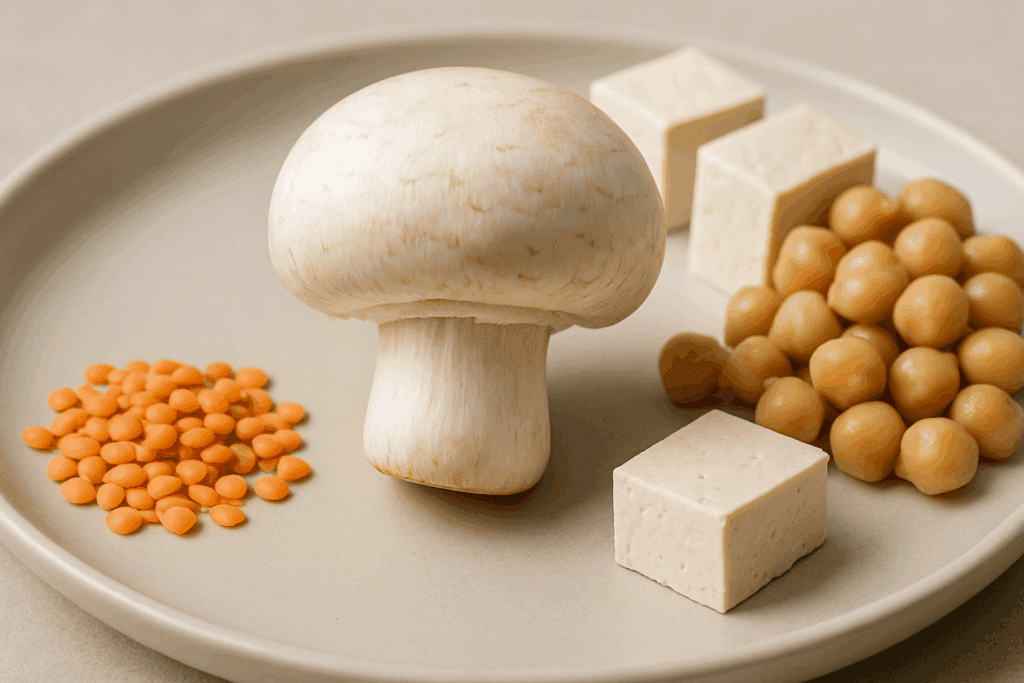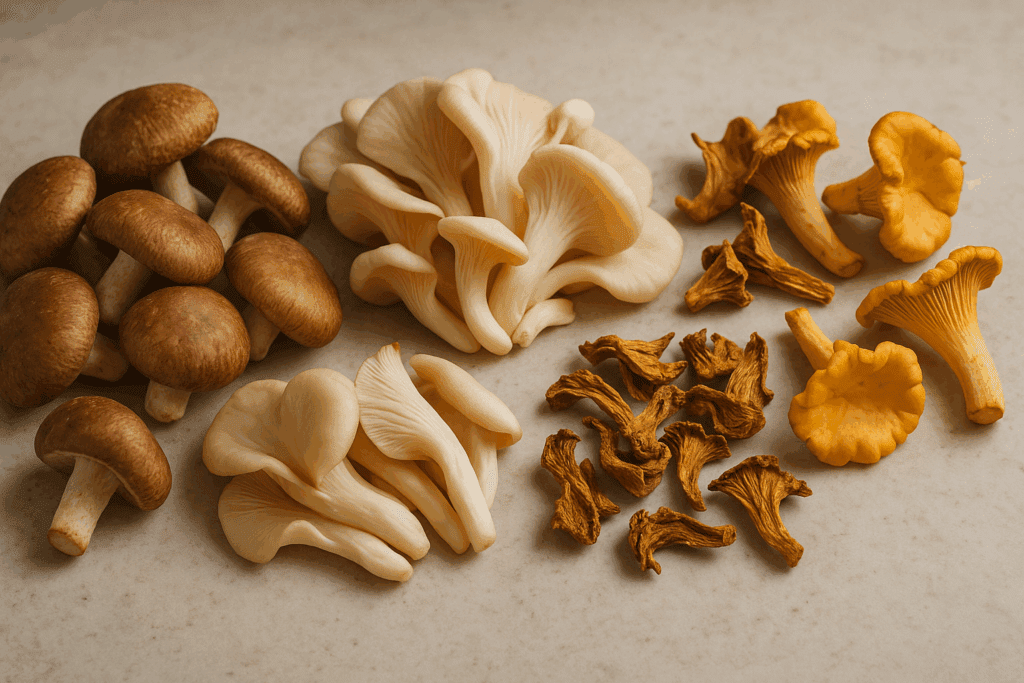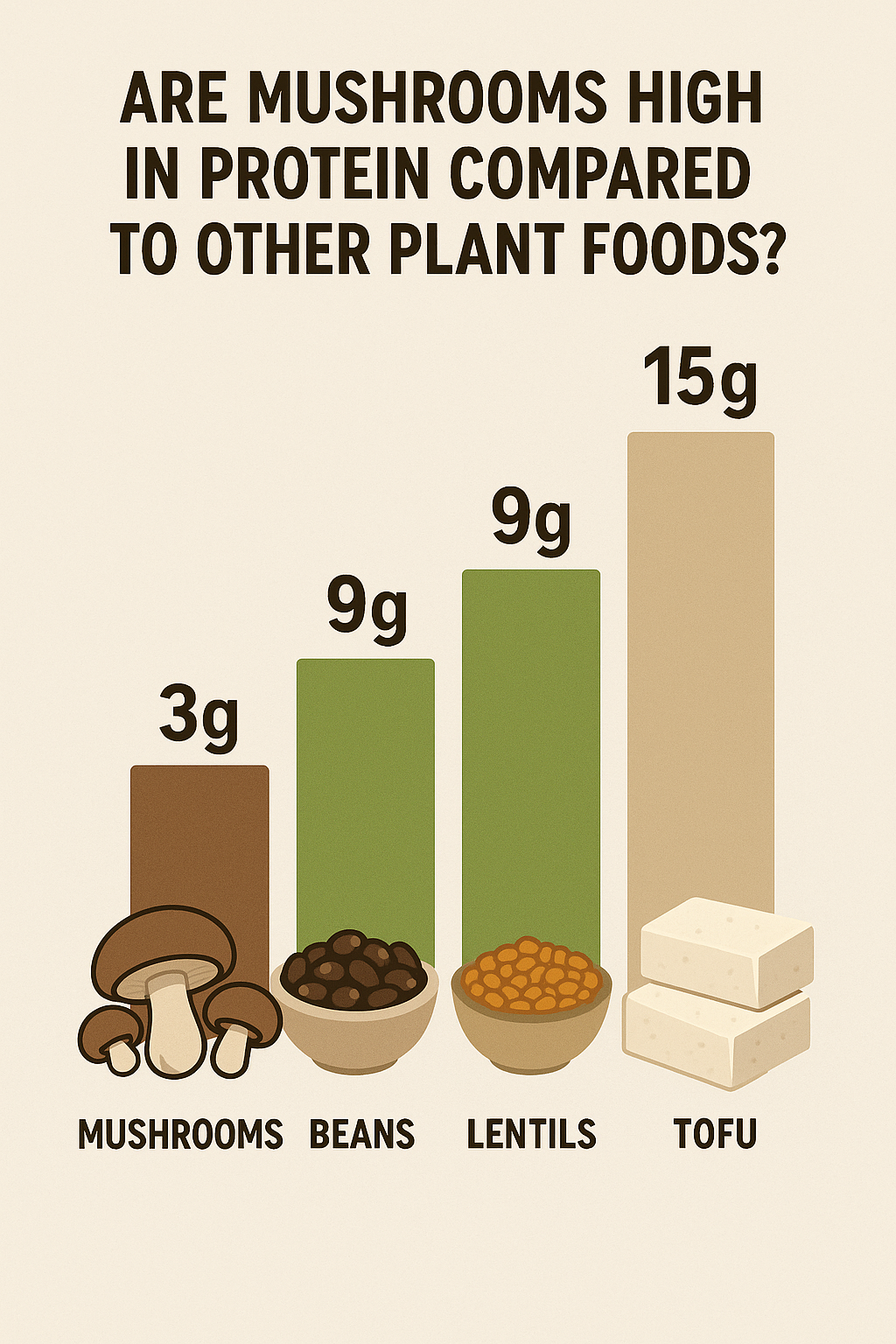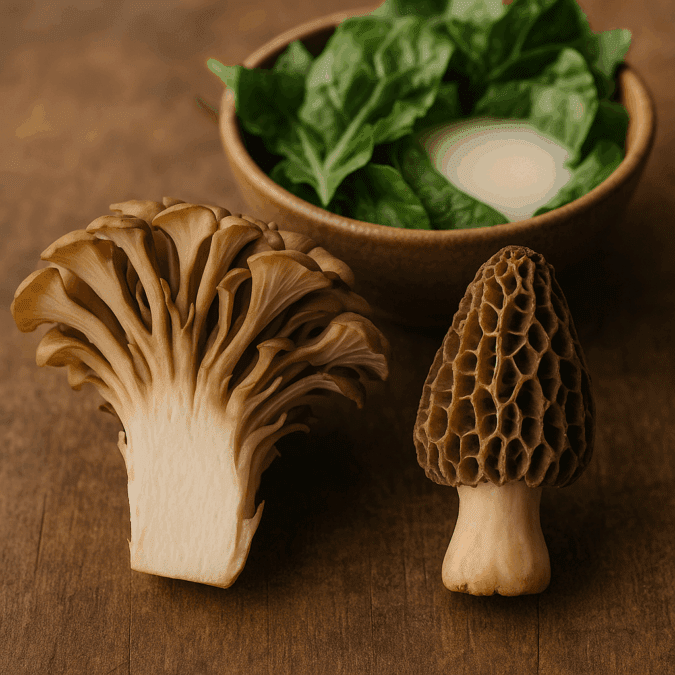Introduction: Unveiling the Hidden Nutritional Power of Mushrooms
When most people think of mushrooms, they often picture them as savory additions to a salad, a pizza topping, or a hearty soup ingredient. Yet behind their culinary versatility lies an intriguing question that deserves thoughtful exploration: are mushrooms a good source of protein? As more individuals seek plant-based or alternative protein options, the interest in understanding mushroom protein has grown considerably. Alongside this, curiosity about the calcium in mushrooms and their overall nutritional contribution continues to rise. This article dives deeply into these aspects, weaving together science-backed insights to offer a comprehensive view of mushrooms’ true nutritional value.
You may also like: How Lion’s Mane Supplements May Support ADHD and Cognitive Clarity: What Science Says About Lions Mane for Focus and Brain Health
Mushrooms occupy a unique niche in the food world. Neither plant nor animal, these fascinating fungi bring a spectrum of benefits that challenge traditional nutritional categorizations. This exploration into mushrooms’ protein content will not only answer whether mushrooms have protein, but will also uncover the nuanced roles they play in a balanced diet. Furthermore, we will look into calcium in mushrooms, and how this mineral complements the broader array of nutrients found within these humble superfoods. As we journey through the science and practical considerations surrounding mushroom nutrition, readers will gain a well-rounded understanding of why mushrooms deserve a central place in discussions about health, wellness, and dietary planning.
Understanding the Basics: Do Mushrooms Have Protein?
Before addressing more complex aspects of mushrooms’ nutritional profile, it is crucial to tackle a fundamental question: do mushrooms have protein? The answer is a resounding yes. However, the context is important. While mushrooms do contain protein, the amount and biological quality differ from traditional animal-based proteins. Mushrooms provide essential amino acids, but not always in the proportions needed to fully match human dietary requirements without supplementation from other protein sources.
On average, 100 grams of raw white button mushrooms contain about 3 grams of protein. This may seem modest when compared to meats or legumes, but it is significant considering their low calorie and fat content. Importantly, the type of protein found in mushrooms exhibits a reasonably balanced amino acid profile, including lysine and leucine, which are often limiting factors in plant proteins. This makes mushroom protein particularly valuable in vegetarian and vegan diets where diversity of protein sources is key to achieving nutritional adequacy.
Another compelling point is that certain varieties, like oyster and shiitake mushrooms, offer even higher protein content compared to common white mushrooms. Thus, when asking “do mushrooms have protein,” it is crucial to recognize the variability among species and preparation methods. Dried mushrooms, for example, have a concentrated protein content due to water removal, enhancing their nutritional density.

Mushrooms Protein Content: Comparing Species and Preparation Methods
When exploring mushrooms protein content more deeply, it becomes clear that not all mushrooms are created equal. Variations in species, cultivation methods, and processing can greatly influence the nutritional value. For instance, oyster mushrooms boast approximately 3.3 grams of protein per 100 grams when fresh, while shiitake mushrooms come in slightly lower but still notable. Chanterelles, another gourmet favorite, offer around 1.5 grams per 100 grams, making them a lighter protein source.
Drying mushrooms dramatically shifts their protein profile. As water evaporates, nutrient density intensifies, making dried mushrooms a potent source of mushroom protein. Dried shiitake mushrooms, for example, can offer up to 10-12 grams of protein per 100 grams, showcasing a significant jump compared to their fresh counterparts. This concentration effect can be harnessed by incorporating dried mushrooms into soups, stews, and sauces.
Cultivation methods also play a subtle but important role. Mushrooms grown in enriched substrates, particularly those supplemented with protein-rich agricultural byproducts, may exhibit slightly higher protein levels. Additionally, environmental factors like light exposure and growing temperature can influence not only protein content but the broader nutrient profile. Therefore, when evaluating mushrooms protein content, it is crucial to consider the specific type of mushroom, how it is grown, and how it is prepared.

Are Mushrooms High in Protein Compared to Other Plant Foods?
When discussing whether mushrooms are high in protein, context matters greatly. Compared to beans, lentils, and soy products, mushrooms are not as protein-dense. A cup of cooked lentils, for instance, can contain upwards of 18 grams of protein, far surpassing what mushrooms offer. However, when compared to other vegetables, mushrooms perform impressively well.
Mushrooms generally provide more protein per calorie than many leafy greens and common vegetables like carrots, cucumbers, or zucchini. This positions them uniquely in plant-based diets where every gram of protein counts. Moreover, mushrooms carry a distinct advantage: they deliver their protein content alongside a suite of micronutrients and bioactive compounds, including ergothioneine and beta-glucans, which provide additional health benefits beyond mere macronutrient contribution.
Another important consideration is how mushrooms can synergize with other foods. Although not a complete protein source by themselves, mushrooms can be paired with legumes, grains, or seeds to create a more balanced amino acid intake. Therefore, while the answer to “are mushrooms high in protein” depends on comparison points, they undoubtedly offer meaningful protein contributions within a well-constructed diet.

Are Mushrooms a Good Source of Protein for Specific Diets?
The question of whether mushrooms are a good source of protein becomes even more nuanced when viewed through the lens of specific dietary patterns. For vegetarians and vegans, mushrooms can serve as a valuable part of a diversified protein strategy. Their umami flavor and satisfying texture also help replicate the sensory experiences often associated with meat, making them a psychologically as well as nutritionally satisfying substitute.
For individuals following low-calorie or weight-loss diets, mushrooms offer an exceptionally favorable protein-to-calorie ratio. Because they are low in calories but still contribute to satiety, they can help in crafting meals that are filling yet calorie-conscious. This makes them an ideal addition to soups, stir-fries, and salads.
In ketogenic or low-carb diets, mushrooms fit comfortably within carbohydrate restrictions while still delivering fiber, antioxidants, and a modest amount of protein. Their versatility allows them to function as a base for dishes that might otherwise rely heavily on carbohydrate-rich ingredients.
Athletes and bodybuilders might not rely on mushrooms as a primary protein source but can still benefit from their anti-inflammatory and immune-supporting properties, which are crucial during intense training periods. Thus, while mushrooms alone might not meet high-protein needs, they undoubtedly enrich a diet in ways that extend beyond just protein counts.
Exploring Calcium in Mushrooms: An Overlooked Benefit
While much attention is given to mushroom protein, another nutritional aspect deserves recognition: calcium in mushrooms. Although not typically celebrated as a major calcium source, mushrooms do contribute to daily calcium intake, particularly certain varieties and fortified products.
Wild mushrooms, such as maitake and morels, naturally contain higher levels of calcium compared to cultivated varieties. On average, 100 grams of raw maitake mushrooms deliver about 2-3% of the recommended daily intake for calcium. Though this may seem minor, it becomes meaningful when mushrooms are eaten in larger quantities or when incorporated consistently into meals.
An exciting development in recent years is the emergence of UV-exposed mushrooms. When exposed to ultraviolet light, mushrooms can dramatically boost their vitamin D2 content. Some research suggests that vitamin D also plays a synergistic role in calcium metabolism, supporting bone health and calcium absorption. Therefore, while calcium in mushrooms alone may not rival dairy products, their role in enhancing overall bone-supportive nutrition is important.
Additionally, ongoing agricultural innovation is exploring ways to biofortify mushrooms, enhancing their natural mineral content, including calcium. This raises the possibility that future mushroom varieties might provide even more substantial calcium contributions, further solidifying their place in comprehensive nutritional planning.

Do Mushrooms Have a Lot of Protein? Examining Practical Serving Sizes
Another common inquiry is “do mushrooms have a lot of protein” in practical, everyday serving sizes. Typically, a serving of cooked mushrooms, about one cup or roughly 150 grams, provides approximately 4.5 to 5 grams of protein. While this amount does not rival animal-based proteins or dense plant-based proteins like tofu, it is nonetheless meaningful, especially when considered in the context of an overall meal.
In a culinary setting, mushrooms are rarely consumed in isolation. They are frequently paired with other foods, providing both flavor and nutritional depth. For instance, combining sautéed mushrooms with quinoa or chickpeas can create a meal with robust protein totals and complementary amino acid profiles. This strategy highlights how mushrooms, while not protein powerhouses on their own, contribute significantly when thoughtfully integrated into balanced meals.
It is also worth considering that mushrooms can “scale” well in dishes. It is easy to add substantial quantities of mushrooms to a recipe without drastically increasing calorie counts, thereby boosting protein intake in a low-calorie, nutrient-rich manner. Thus, in answering “do mushrooms have a lot of protein,” the practical answer is that they provide a valuable contribution, particularly when used creatively and abundantly in meals.
Health Benefits Beyond Protein: The Broader Nutritional Spectrum of Mushrooms
While the conversation often centers around mushroom protein and calcium in mushrooms, these fungi offer a rich tapestry of additional health benefits that warrant attention. Mushrooms are rich sources of B vitamins, particularly riboflavin, niacin, and pantothenic acid, which are essential for energy metabolism and neurological function.
They also supply important antioxidants, such as ergothioneine and glutathione. These compounds help combat oxidative stress, a driver of chronic diseases ranging from heart disease to neurodegenerative conditions. Emerging research even suggests that regular mushroom consumption may support cognitive health and reduce the risk of mild cognitive impairment.
Moreover, mushrooms provide important dietary fiber, particularly in the form of beta-glucans, which can modulate immune function and support gut health. Beta-glucans have been shown to enhance macrophage and natural killer cell activity, bolstering the body’s first line of defense against infections and possibly tumors.
Selenium, copper, potassium, and iron are additional minerals found in mushrooms, each playing a role in critical bodily functions from oxygen transport to nerve transmission. Thus, when considering the role of mushrooms in the diet, it is essential to appreciate their multi-dimensional contributions to health, extending well beyond the domains of protein and calcium.
The Future of Mushroom Nutrition: Innovations and Possibilities
As scientific interest in mushrooms continues to expand, exciting innovations are emerging. Researchers are developing mushroom-based protein powders and meat substitutes designed to enhance the dietary protein landscape. These products often involve blending mushrooms with legumes or grains to create complete protein profiles suitable for a wide range of diets.
There is also ongoing exploration into genetically enhancing mushrooms to increase their nutritional density, including boosting protein, calcium, and antioxidant contents. Bioengineering efforts aim to harness mushrooms’ natural resilience and adaptability to create superfoods that can support global nutrition and food security.
Additionally, mushroom farming is becoming more sustainable, with innovations that reduce water use, minimize carbon footprints, and recycle agricultural waste. Thus, mushrooms not only promise nutritional benefits but also represent a forward-looking solution to environmental and ethical challenges associated with conventional protein sources.

Frequently Asked Questions (FAQ): Mushroom Protein, Calcium, and Nutritional Insights
1. Can mushrooms help meet daily protein needs for athletes or highly active individuals?
While mushrooms do offer valuable nutrition, their protein content alone may not fully satisfy the heightened needs of athletes. However, when used creatively, mushrooms can supplement an active lifestyle very effectively. Combining mushrooms protein content with other sources such as quinoa, lentils, or plant-based powders can create a protein-rich meal tailored for muscle recovery and endurance. It’s important to recognize that while mushrooms are a source of protein, they work best as a complementary ingredient rather than the sole protein provider for athletes. Their antioxidant compounds, including ergothioneine, can also help combat exercise-induced oxidative stress, offering additional recovery support beyond just mushroom protein.
2. How does the calcium in mushrooms compare to fortified plant-based milk alternatives?
Calcium in mushrooms, while present, is significantly lower compared to fortified plant-based milks like almond or oat milk. However, calcium in mushrooms comes naturally, without additives, and often alongside bioactive compounds that may enhance mineral absorption. Interestingly, UV-exposed mushrooms also contribute vitamin D2, which synergizes with calcium metabolism, an advantage most fortified beverages do not naturally provide. While mushrooms alone may not fulfill calcium daily values, integrating them into a diverse diet can enhance long-term bone health. Thus, even though mushrooms protein content and calcium are modest individually, their natural bioavailability offers a distinct advantage.
3. Are mushrooms a good source of protein for seniors concerned about muscle loss?
Sarcopenia, or age-related muscle loss, makes maintaining sufficient protein intake essential for seniors. Although mushrooms protein content isn’t high compared to meat or legumes, mushrooms still play a valuable supporting role in older adults’ diets. When paired with protein-dense foods like eggs, tofu, or Greek yogurt, mushrooms create nutrient-dense meals that are easy to digest and rich in antioxidants. Furthermore, calcium in mushrooms, though not abundant, complements their overall bone-supportive profile. Therefore, while mushrooms alone won’t prevent muscle loss, they certainly enhance a senior’s protein strategy when thoughtfully incorporated.
4. What are some culinary strategies to maximize mushroom protein intake?
Cooking methods and dish choices can amplify mushroom protein contributions in daily meals. Grilling or roasting mushrooms concentrates their flavors and nutrients without excessive water dilution. Blending dried mushroom powder into smoothies or protein shakes also boosts mushroom protein conveniently and subtly. Stir-frying mushrooms alongside tofu, tempeh, or chickpeas helps create a dish where mushrooms protein content meaningfully contributes to total intake. Moreover, using multiple mushroom varieties—such as oyster, shiitake, and maitake—in one recipe can enhance both flavor complexity and nutritional profile.
5. Are mushrooms a viable protein source for children following plant-based diets?
Mushrooms can serve as a creative, supportive protein component in plant-based meals for children, although they should not be the sole source. While asking “do mushrooms have protein,” the answer is yes, but their protein density is lower than needed for rapid childhood growth. However, mushrooms offer additional critical nutrients such as selenium, B vitamins, and even small amounts of calcium in mushrooms, which are essential for growing bodies. Parents can incorporate mushrooms into child-friendly meals like pasta sauces, taco fillings, and blended soups to introduce both taste and nutritional benefits early. Therefore, while not a primary protein powerhouse, mushroom protein still holds an important place in balanced children’s diets.
6. What are the environmental benefits of choosing mushrooms as part of a protein strategy?
When considering sustainable eating, mushrooms offer a compelling advantage. Compared to animal farming, mushroom cultivation uses significantly less land, water, and energy, making mushrooms protein content an eco-friendlier choice. Even though mushrooms are not as protein-dense as beef or poultry, incorporating them can help reduce the environmental impact of meals. Additionally, many mushroom farms operate using agricultural byproducts as growing mediums, further enhancing sustainability. Thus, when asking “are mushrooms a good source of protein” from an ecological perspective, the answer is a resounding yes in terms of environmental footprint reduction.
7. Do mushrooms have a lot of protein compared to trendy superfoods like spirulina or hemp seeds?
Comparatively, mushrooms have less protein per serving than concentrated superfoods like spirulina or hemp seeds. For instance, a tablespoon of spirulina delivers around 4 grams of protein, similar to a full cup of cooked mushrooms. However, mushrooms offer something these powders often lack: culinary versatility and fiber-rich, satiating bulk. When evaluating “do mushrooms have a lot of protein,” it becomes clear that while they are moderate, their contribution shines when considering the broader context of whole-food nutrition. Combining mushrooms with seeds, nuts, or microalgae can create nutrient-dense meals rich in complete proteins.
8. How can biofortification improve the calcium content in mushrooms in the future?
Biofortification techniques—selective breeding or natural enrichment—could significantly enhance calcium in mushrooms over the coming years. Scientists are exploring ways to grow mushrooms on substrates fortified with calcium minerals, resulting in higher uptake by the fungi. Such innovations could make mushrooms not only a better source of protein but also a competitive calcium provider. Future calcium-enriched mushrooms could support plant-based eaters and populations with limited access to dairy. Thus, as mushroom protein and calcium profiles are optimized through biofortification, their role in public nutrition will become even more significant.
9. Is it possible to develop complete-protein meals using mushrooms as a base?
Absolutely, creating complete-protein meals featuring mushrooms is both practical and delicious. Because mushrooms protein content lacks some essential amino acids, pairing them with complementary foods like quinoa, buckwheat, or soy ensures a complete amino acid profile. For example, a stir-fry featuring oyster mushrooms and quinoa, tossed with sesame seeds, would satisfy both protein quality and culinary excellence. By understanding how “are mushrooms a source of protein” and strategically complementing them, chefs and home cooks alike can build meals that rival traditional animal protein dishes in nutritional value. This strategy encourages creativity and culinary innovation in plant-based cooking.
10. Are there emerging mushroom varieties particularly bred for higher protein or calcium content?
The field of mycology and agricultural science is rapidly advancing, and selective breeding for enhanced mushrooms protein content and calcium levels is underway. Hybrid species like “protein-rich king oyster mushrooms” are in development to provide more substantial nutritional benefits. Additionally, some wild strains naturally exhibit higher levels of both protein and calcium in mushrooms, inspiring cultivation efforts to bring these traits to commercial varieties. As consumer demand grows for nutrient-dense, plant-based foods, mushroom breeders are focusing more on enhancing these critical nutritional aspects. Thus, the next decade promises a wave of mushrooms that redefine expectations for functional and sustainable nutrition.

Conclusion: Are Mushrooms a Good Source of Protein and Nutrition? A Final Word
In reflecting on the question “are mushrooms a good source of protein,” the evidence reveals a nuanced but affirmative answer. While mushrooms may not rival animal products or dense legumes in sheer protein quantity, their contribution to dietary protein is both meaningful and strategically valuable. When viewed in the broader context of their rich array of nutrients—including calcium in mushrooms, essential vitamins, antioxidants, and bioactive compounds—they emerge as true nutritional powerhouses.
Understanding mushrooms protein content, the answer to “do mushrooms have protein,” and the benefits of integrating these versatile foods into daily meals underscores their importance in modern diets. Whether supporting plant-based eating, enhancing micronutrient intake, or contributing to sustainable food systems, mushrooms offer a compelling combination of flavor, nutrition, and ecological responsibility.
Was this article helpful? Don’t let it stop with you. Share it right now with someone who needs to see it—whether it’s a friend, a colleague, or your whole network. And if staying ahead on this topic matters to you, subscribe to this publication for the most up-to-date information. You’ll get the latest insights delivered straight to you—no searching, no missing out.
Further Reading:
Nutritional Quality and Biological Application of Mushroom Protein as a Novel Protein Alternative
What to know about the health benefits and nutritional values of mushrooms
Important Note: The information contained in this article is for general informational purposes only, and should not be construed as health or medical advice, nor is it intended to diagnose, prevent, treat, or cure any disease or health condition. Before embarking on any diet, fitness regimen, or program of nutritional supplementation, it is advisable to consult your healthcare professional in order to determine its safety and probable efficacy in terms of your individual state of health.
Regarding Nutritional Supplements Or Other Non-Prescription Health Products: If any nutritional supplements or other non-prescription health products are mentioned in the foregoing article, any claims or statements made about them have not been evaluated by the U.S. Food and Drug Administration, and such nutritional supplements or other health products are not intended to diagnose, treat, cure, or prevent any disease.


